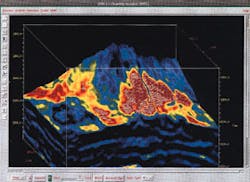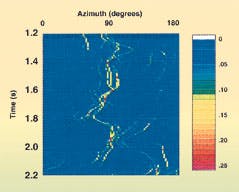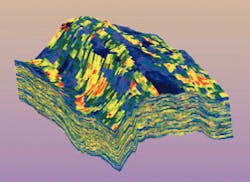Geoscience
With SeisWorks, a user can associate multiple reservoir properties with seismic attributes to uncover subtle reservoir information and probable hydrocarbons. [Courtesy Landmark Graphics]
Western's Fractogram clearly illustrates fracture azimuth derived from the periodic amplitude variation of real P-wave data. [Courtesy Western Geophysical]
3D permeability realization of a North Sea field. [Courtesy British Gas]
Pardo's Project Alpha
Georges Pardo was an extraordinary man decades ahead of his time. It was he, in the late 1960s and early 1970s, who developed the idea of bright spots, and it was he in 1980, who first theorized that hydrocarabons might lie beneath salt structures, which, he maintained at the time, were not bottomless barriers to petroleum exploration but whose bottoms could be visualized, and thereafter the strata underlying it could be known.
David Brown, in the current issue of AAPG Explorer, tells the remarkable story of Pardo and his Project Alpha, an attempt some 17 years ago by an ad hoc Gulf Oil group to map deep, subsalt reflections on Gulf of Mexico seismic data. Pardo was a geologist with Gulf at the time. He was joined in the group by now manager of technology and exploration at Anadarko Petroleum, Michel D. Cochran, present geological consultant with Chevron Overseas Petroleum, Timothy A. Anderson, and Suzan Brice, now president of Voyager Exploration.
It was Pardo, however, who was the ramrod of Project Alpha. He was then and is now (despite being retired) extremely enthusiastic about the Gulf. "I think it's the best province in the continental United States, especially as you go deeper." He began a serious study of Gulf seismic back when "everybody assumed that once you hit salt it was the end of the world."
Pardo knew better. "Every once in a while, if you had good seismic data on a salt dome, you would see a strong event that came out at about the depth of basement," he said. "In about nine out of ten cases, you can see that event, which to me is really a basement reflection, but it comes halfway up into the section because of the high velocity of the salt. There was something below what appeared to be the salt, especially when you went from the break of the continental shelf to the slope. It was happening so often that there was a good reason to start looking at it."
He rightly believed that the processing methods of the time were keeping interpreters from seeing subsalt sediments, so he tried to persuade Gulf to assess the subsalt in the Gulf of Mexico, despite a dwindling rate of discovery there and an overweening skepticism in the company and the industry at large.
Finally, Gulf acquiesced and agreed to a small project - the Alpha Project, to test Pardo's theories. Beginning with data shot on spec in the 1970s, the group had a regional shoot to analyse, but its resolution was poor and its orientation was at a 45! angle to the shore. By doing their own interpretation and assisted by a new regional survey, the team gradually put together a model from pieces of seismic, according to Brice.
Gulf bought a number of blocks in the May 1983 lease sale based on the team's mapping, and to test the subsalt concept, spudded a well on West Cameron 505, which, as the team predicted, encountered salt. Rather than move on, however, they kept drilling through the salt, some 1,670 ft until they broke through on the bottom side and emerged in Pliocene-Miocene sediments. A second well in Eugene Island 324 confirmed the discontinuity without going through a salt layer.
According to Anderson, the groups understanding of the subsalt after evaluation of the test wells was excellent. They were ready for a discovery by 1984, but in March of that year, Gulf Oil merged with Standard Oil of California and became Chevron Corp. and Project Alpha was dropped.
Brice maintains, nevertheless, that the project paved the way for today's subsalt successes. "Sometimes you're too far out in front," Cochran said of Pardo. "You just have to wait for everything to catch up. Drilling in the 1990s proved what he began to suspect in the mid-1960s."
Landmark's SeisWorks 3.0
Landmark Graphics has released its SeisWorks 3.0, a major upgrade to its integrated geophysical interpretation suite. The new release enables interpreters to move beyond structural interpretation to volume characterization and definition of reservoirs for greater success in drilling and production. The SeisWorks 3.0 family permits incorporation of more critical seismic and well data for greater accuracy in determining the size, shape, nature, and location of a reservoir during exploration, development, and production. With it, geoscientists can now analyze data between boundaries.
Azimuthal P-wave fracture detection
Fracture detection required the use of costly and complex multicomponent shear-wave technology until quite recently, when Western Geophysical developed its patented P-wave fracture detection method that uses existing technology and significantly reduces costs. By offering modeling, survey design, acquisition, and processing of azimuthal P-wave data for fracture detection, Western's approach assists in the detection of fractures through collecting an adequate number of azimuths - important in areas where fractures control the porosity of carbonate reservoirs.
BG saving costs via 3D models
British Gas first began utilizing 3D modeling in late 1994, and has since completed three modeling studies in the UK North Sea Continental Shelf. Another field study is underway, and two potential international field studies are now being evaluated. BG created its own focused, multi-disciplinary R&D Reservoir Modeling Team to carry out these studies, and has developed leading edge skills in reservoir modeling since, which have helped the company optimize its field development strategies and reduce reservoir development costs.
The Team essentially analyzes new reservoir modeling technology and transfers applicable methods to BG's exploration and production sector. The visualization aspect of 3D modeling permits the integration of disparate data into a cohesive model that promotes cross-discipline understanding. According to spokesmen, this has already had a positive impact on BG's goal of $3/bbl in field development costs.
Subsalt '97 proceedings
The Subsalt Technology Conference, Subsalt '97, presented in Houston in January by Offshore Magazine. An abbreviated proceedings with papers and abstracts is available through Offshore Magazine. Subsalt '98 will be in New Orleans February 13-15, 1998.
Copyright 1997 Oil & Gas Journal. All Rights Reserved.


